The Danish composer Fuzzy has musically decorated The Black
Diamond with his work Katalog (Catalogue) which is inspired by the treasures of the
library and presents 52 electro-acoustical works of which one is played every day at 1.00-1.03 p.m. - a new
work every week.
The music can be heard in the big atrium of the library (called "The Chip") between the
balconies, glass walls and transverse bridges.
Below we present the pictures and a short description of the objects from the library which
have inspired Fuzzy for the music of the individual weeks in July and August (week no. 27-35).
Back to the index
Week 27
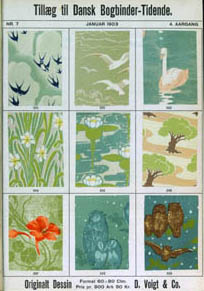
The Danish Department stores all back issues of Danish trade journals from their original
appearance, and an illustrated advertisement in Dansk Bogbinder-Tidende (The Danish
Bookbinder's Times) 1903 indicates clearly the then current efforts to enliven the end-papers
used between the binding and the book. These figured patterns turn up in numerous publisher's
bindings from 1903 and onwards. No. 202 with its seagull motif was most appropriately used in
that same year for Zacharias Nielsen's novel The Seagull!
University Library Department.
Week 28
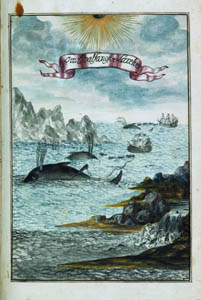
Hans Lillienskjold: Speculum boreale, i.e. a description of Finmarken in Northern Norway,
dated 1701. Lillienskjold was the "prefect" of Finmarken, and based his description on his own
observations as well as his access to the county archives. The manuscript is generously provided
with coloured pictures: here the the illustration to the section On Whaling and Salmon Streams.
Dedicated to Frederik IV, but ended up in Thott's possession, as did several other manuscripts
from the archives or the king's private library.
The Manuscript Department,
Thott 948, folio.
Week 29
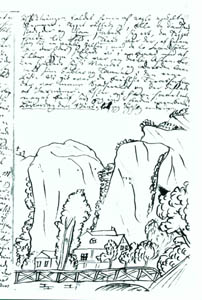
A page of H.C.Andersen's diary from 1831 with entries for June 3-4, during which he visited
Dredsen and its surroundings. The drawing is from a visit to "plaunscher Grund", and he writes
about the scene: "A little stream twisted and turned with the road between the steep
mountainsides. The bridge and the mill placed there looked delightful." H.C.Andersen was an
intimate friend of the Collin family and the diary was, together with a large number of other
Andersen memorabilia, incorporated into the Manuscript Collection in 1905 as part of
The Collin Collection of Manuscripts and Letters.
The Manuscript Department, Collin 30, kvarto. All H.C. Andersen's
diaries can be found online.
Week 30
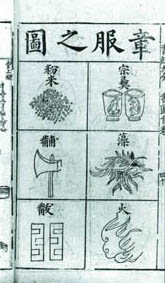
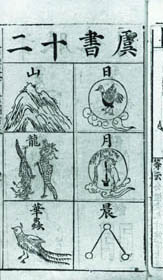
The twelve symbols of the imperial power. From an illustrated edition of the Chinese classic
"Shujing" (The book of history) in 10 volumes . Published in block prints in 1580.
The Oriental Collection, OA 102-1977-57, kvarto.
Week 31

An illustration in a Nepalese manuscript of what is known as the kundalini, which
the Indians view as the powerful energy center in human beings located at the base of the
backbone. To activate the Kundalini is only possible through the most advanced techniques of
yoga, but when this happens, violent powers are liberated, rising through the psychic energy
centers located on a line from the point of origian to the top of the head. This drawing
measures 184 x 23 cm.
The Oriental Collection, Nepal 92.
Week 32
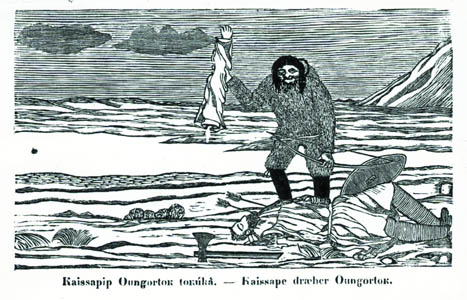
From the first volume of H. Rink's bi-lingual edition of Greenlandic folktales as told by
natives and with woodcuts also done by a native Greenlander. This first volume published
in Godthåb in 1859 was followed by three more, 1860-63. The artist was the Greenlander
Aron from Kangek.
University Library Department, 59 - 36, oktavo.
Week 33
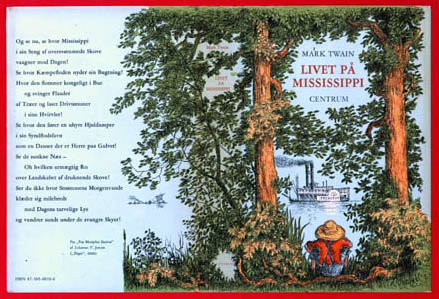
Great numbers of American books - literary works, non-fiction and many accounts of American
social and cultural conditions - have been translated into Danish over the years. The book
illustrator Ib Spang Olsen's conception of the romantic Old South ornaments the cover of a
translation of Mark Twain published in 1979, accompanied by a famous poem by Johs. V. Jensen
from 1906.
University Library Department.
Week 34
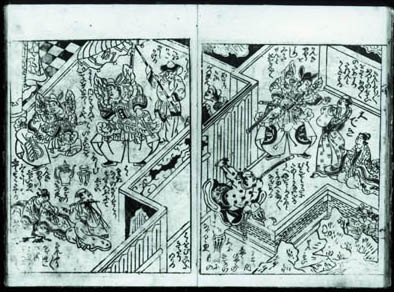
Puppet theater scenes from a rare collection of five of the puppet theater plays known as
jooruri, with woodcuts and text summaries printed in Japan, presumably in the 1700s.
Here are scenes from the popular play "Kokusen'ya kassen" from 1716. the hero, Watonai, who has
a Japanese mother and a Chinese father, travels to China to defeat the Tatar king and his
Chinese general Kanki. The high point of the drama is the dilemma that Kanki's wife is placed
in when she realizes that Watonai is her Japanese brother. The dilemma is resolved by her
suicide (lower left corner).
The Oriental Collection, OA 93-158, oktavo.
Week 35
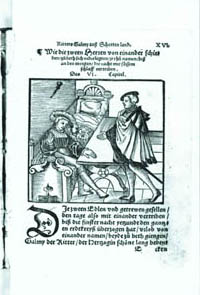
Among three entertaining books which only have been preserved in a few copies: Title-page of
the story of Tristan and Isolde, printed in Worms c. 1550.
The Manuscript Department,
Rare Book Collections,
kvarto (Pegg nr. 3649).
Back to the index
Comments for The Music and Theatre Department
Updated 3.9. 2004











